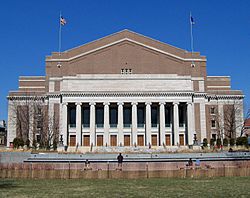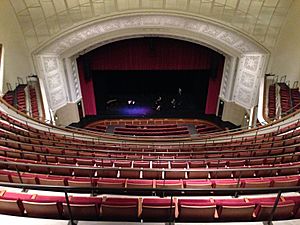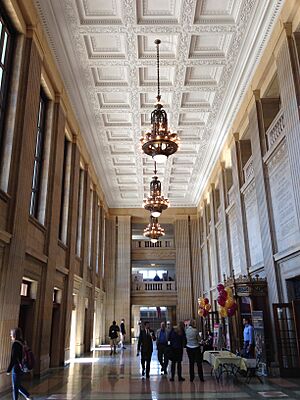Northrop Auditorium facts for kids
|
Grande Dame of the Twin Cities
Heart of the University of Minnesota |
|

Northrop as seen from Northrop Mall
|
|
| Full name | Cyrus Northrop Memorial Auditorium |
|---|---|
| Address | 84 Church Street SE Minneapolis, MN 55455-0281 |
| Location | Northrop Mall, University of Minnesota |
| Owner | Board of Regents of the University of Minnesota |
| Operator | University of Minnesota Tickets and Events |
| Capacity | 2,692 (2014–present) 4,847 (1929–2011) 168 (Best Buy Theater) |
| Construction | |
| Broke ground | April 30, 1928 |
| Opened | October 22, 1929 April 4, 2014 (grand reopening) |
| Renovated | 2006 (exterior) 2011-2014 (interior) |
| Closed | 2011-2014 |
| Construction cost | $1.2 million (1929) $21 million (2006 exterior restoration) $88.2 million (2011-2014 interior renovation) |
| Architect | Clarence H. Johnston, Sr. (1929) HGA (2014) |
| Tenants | |
| Minneapolis Symphony Orchestra (1929-1974) Weisman Art Museum (1934-1993) University of Minnesota Marching Band (1929-2009) |
|
Cyrus Northrop Memorial Auditorium (often called Northrop Auditorium or just Northrop) is a cool place for performances at the University of Minnesota in Minneapolis, Minnesota. It's named after Cyrus Northrop, who was the university's second president. Lots of different events happen here, like concerts, ballet shows, interesting lectures, and even graduation ceremonies.
Northrop is a big building at the top of Northrop Mall. This mall is a grassy area in the middle of the campus. It's surrounded by university buildings for physics, math, chemistry, and administration. Coffman Memorial Union is at the other end of the mall, across Washington Avenue.
Contents
Discovering Northrop's Past: A Look at its History
Building Northrop: How it All Started
Northrop Auditorium was built between 1928 and 1929. It was part of a huge plan to make the university bigger. An auditorium had been planned for Northrop Mall since 1908. But the idea really took off after Cyrus Northrop passed away in 1922.
The auditorium was built to remember Cyrus Northrop and the soldiers from World War I. Students helped raise money, pledging about $80 each. This collected $665,000 in just six months! After more fundraising and talks about the building's size, plans were ready in 1926. The goal was to keep the cost under $1 million.
The first design for the building had a classical front with fancy carvings. But this would have cost too much and looked out of place. So, the architect, Clarence H. Johnston, Sr., made the design simpler. He used ideas from the Low Memorial Library at Columbia University. The final plans were finished in February 1928.
A special message was added to the building later. It says: "The University of Minnesota: Founded in the Faith that Men are Ennobled by Understanding; Dedicated to the Advancement of Learning and the Search for Truth; Devoted to the Instruction of Youth and the Welfare of the State."
Northrop officially opened on October 22, 1929. The Minneapolis Symphony Orchestra performed first. More celebrations followed with the Boston Symphony and a special program for alumni.
Events and Performances at Northrop
Since it was built, Northrop has been used for many university events. In 1929, it was designed to hold all the students for big meetings. It became the main place for university graduations starting in 1930.
Free public lectures were held every week until 1969. They continued less often into the 1970s. The auditorium was also used for large classes from 1959 to the 1990s.
Dance has been a big part of Northrop's shows since 1932. The Northrop Dance Season started in 1970-1971 and is still going strong. Northrop's stage is one of the only ones in the area big enough for major dance productions.
Pop and rock concerts were rare at first. But they became more common after 1974. A famous concert by the B-52's in 1990 caused part of the ceiling to fall!
Many groups have called Northrop home. The Minneapolis Symphony Orchestra was based here until 1973. The Weisman Art Museum was inside Northrop until its own building was built in 1993. The University of Minnesota Marching Band practiced here until 2009.
A huge pipe organ was installed between 1932 and 1936. It has 6,982 pipes! It's the biggest pipe organ in the Upper Midwest. The organ was removed in 2011 but was fixed up and put back in 2016-2017. Its return was celebrated with concerts in 2018.
Northrop's Big Makeover: Renovation Details
After 80 years, Northrop needed a lot of work. A big renovation of the inside started in February 2011. The goal was to keep the building's historic look while making it a modern performance space.
The renovation reduced the main theater's seating from 4,847 to 2,692. This greatly improved how well people could see and hear. A second theater with 168 seats was added on the fourth floor. The new design also included offices, a dance rehearsal studio, and a main floor cafe.
Important parts like the proscenium arch and historic columns were saved. Memorial Hall, the building's old lobby, was fully restored.
Northrop reopened on April 4, 2014. The American Ballet Theatre performed Giselle on the stage. Since then, Northrop has continued to be a place for art, entertainment, and university events. Dance shows and graduations happen regularly. Lectures and concerts are also common. It's even a popular study spot for students during the day.
In January 2018, Northrop was officially listed as a historic building. It's part of the Northrop Mall Historic District.
Amazing Performances: Notable Concerts at Northrop
Northrop has hosted many famous musicians and bands. Here are some of them:
- Igor Stravinsky
- Louis Armstrong
- Leonard Bernstein - 1945; 1947
- Marian Anderson
- Ella Fitzgerald
- Van Cliburn - 1968
- Grateful Dead - 1971
- Peter, Paul and Mary
- Pete Seeger
- Joni Mitchell - 1976
- Carole King
- Bob Marley - 1978; 1979
- Elton John - 1979
- Frank Zappa - 1981; 1984
- Bette Midler - 1983
- James Taylor - 1986; 2002
- The B-52's - 1990
- Aretha Franklin - 1992
- Bruce Springsteen - 1996; 2005
- Sonny Rollins - 1998
- Kenny G
- Dolly Parton
- Barry Manilow
- Prince - 2000
- Van Morrison - 2004; 2007
- Sheryl Crow
- John Mellencamp
- Paul Simon - 2006
- Neil Young - 2007; 2019
- Bob Dylan - 2008
- John Legend - 2008; 2017
- Kraftwerk - 2015
- Iggy Pop - 2016
- Patti Smith - 2017
- Diana Ross - 2017
- Thom Yorke - 2018
More Cool Events: Other Noteworthy Happenings
Besides concerts, Northrop has welcomed many other important people and events:
- Mary Wigman - January 12, 1932
- Langston Hughes - 1935
- Arnold Toynbee - 1955
- Martin Luther King Jr. - October 16, 1959; January 28, 1963
- Robert Frost
- Metropolitan Opera - multiple dates
- Buckminster Fuller - 1973
- Alvin Ailey, American Ballet Theatre, and New York City Ballet - multiple dates
- Martha Graham
- Mikhail Baryshnikov
- Robin Williams - April 16, 2002
- The Dalai Lama
- Presidents Jimmy Carter, George H. W. Bush, and Bill Clinton
- Supreme Court Justices Antonin Scalia, Sonia Sotomayor, and John Roberts
- Sherman Alexie
- NFL Honors - February 3, 2018
- Jane Goodall
- Gloria Steinem
Images for kids










